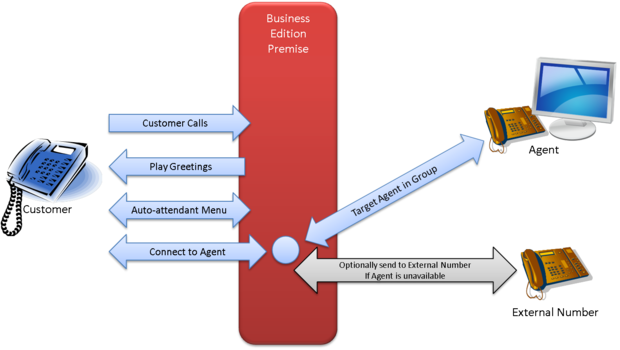Voice routing overview
The Business Edition Premise voice routing application provides essential inbound call center functions using built-in strategies:
- Entry handling based on contact center status
- Auto-attendant (Interactive Voice Response) menus
- Call distribution based on agent availability and call priority
Entry handling
The application receives the incoming call, retrieves the dialed number (DNIS), and applies status conditions to the call. Is the contact center closed, and if so, why?
- Is it a holiday? If so, the caller hears the Special Day announcement.
- Did the call come in outside of normal operating hours? If so, the caller hears the Closed announcement.
- Is an emergency underway? If so, the caller hears the Emergency announcement.
If the contact center is open, the caller hears an announcement or the auto-attendant menu (if one exists), or the call passes directly to an agent.
If you have given the caller a menu of options (“Press 1 for Sales,” and so on), the call passes to the Auto-attendant menu (DTMF) workflow, which specifies the action to be taken depending on the caller’s menu choice. The Auto-attendant flow can cycle up to three times, to accommodate three layers of routing. The Auto-Attendant Menus (DTMF) workflow, diagrammed below, acts as an Interactive Voice Response tree to the customer. It plays a menu announcement configured in the Inbound Template, and assigns a Distribution Parameter Group or an Inbound Parameter Group based on the digit (touch tones) collected. For example: The announcement gives the customer three choices (Press 1 for Customer Service, 2 for Sales, and 3 for Technical Support):
- Touch tone 1 = Customer Service (Distribution Template)
- Touch tone 2 = Sales (Distribution Template)
- Touch tone 3 = Tech Support at Route Point 6001 (the Inbound Template that matches the DNIS for the Technical Support Route Point)
The auto-attendant flow can accommodate up to three cycles during a call. In the example above, Touch tone 2 (Sales) might give the caller a second set of options: for Product A, press 1; for product B, press 2, and so on. To learn how to build your menus, see Voice routing configuration.
Call distribution
The Distribution call flow distributes the call to an agent:
- It collects statistics to determine what agents are logged in and available to take the call.
- It routes the call to an agent from a target agent group: it first tries an agent from Target 1, then, in sequence, tries Targets 2, 3, and 4 if it does not find an agent within the timeout set for that target. Finally, if it does not find an agent from Targets 1-4 within the allotted time, it sends the call to the overflow target, which can be a standard telephone number (such as 415-555-1212) or a routing point (such as 6001). Note that Targets 2-4 are optional; routing skips any undefined targets.
The application plays queue music in a loop until the call is distributed to an agent or abandoned.
Redirect On No Answer (RONA): if the call has already been distributed to an agent who does not answer, the Distribution flow distributes the call as if it had not been previously distributed, and sets to Not Ready the status of the agent who did not answer.

